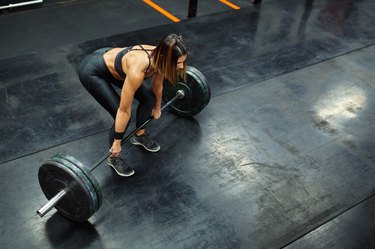
Having a balanced physique requires more than just training your upper body. To add size to your frame, you need to spend time working out the legs. Training the large muscles in the lower body stimulates an increase in testosterone and other growth hormones, which results in more lean muscle mass.
Tip
In addition to resistance exercises for your upper body, training the large muscles in your lower body will help your body get bigger faster.
Video of the Day
Working Out the Legs
It's no secret that working out the legs demands more from your body than many other workouts. That's why you often feel spent after training in the gym. Since the lower body is home to some of the largest muscles in your body, it's critical to develop mass in these muscles, which include the quadriceps, glutes, hamstrings, hip flexors and calves.
Video of the Day
And if you want to increase the overall size of your body, you need to simulate the release of testosterone, which is a steroid hormone produced in your body that plays a significant role in helping grow skeletal muscles.
Another hormone that plays a role in muscle growth is human growth hormone or HGH, which is an anabolic peptide hormone. To stimulate the production of HGH, the American Council on Exercise (ACE) recommends high-intensity exercise such as heavy strength training or explosive power training.
Hitting all the major muscle groups at a moderate to heavy resistance at least two to three days a week can help elicit these changes. That said, it's important to note that two to three days is the minimum recommendation for increasing size.
If you have an intermediate fitness level, the National Strength and Conditioning Association (NSCA) suggests increasing the training frequency to three or four days per week. And advanced lifters can bump that frequency up to four to six days per week to allow for an even greater increase in training stimulus.
However, both the intermediate and advanced programs require a different approach than using a full-body routine. If you plan on training four or more days a week, the NSCA says you will need to adopt a split route that spreads four or more workouts evenly across the week.
Read more: The Best Leg Exercises for Muscle Definition
Importance of Compound Movements
If you're a seasoned gym-goer, there's a good chance you know how important it is to include compound exercises in your workouts. You probably also understand the importance of leg workouts, especially when your focus is on compound movements.
Including compound exercises in your workout enables you to train multiple muscle groups at the same time, which maximize strength gains and muscle hypertrophy. It also allows you to work out more efficiently and effectively.
By performing compound moves such deadlifts, squats and barbell lunges, you can help increase the level of testosterone in your body. In fact, if you want the most bang for your buck when it comes to stimulating the testosterone response, the American Council on Exercise says you need to perform heavy resistance training using multi-joint compound movements for the larger muscles groups, hence, the importance of leg workouts.
Designing a workout routine around compound movements is a lot easier than you might think. Start with exercises for working out the legs such as squats, deadlifts, hip thrusters, barbell lunges and barbell step-ups. Then, add upper-body compound exercises like chest press, shoulder press, lat pulldown and rows. If you have time, you can include a few isolation exercises such as biceps curl or triceps extension.
Read more: List of Compound Exercises
How to Avoid Overtraining
When getting bigger is your goal, being smart about how you train is critical for success. One common mistake that occurs when exercising with heavier weights and at a higher intensity level is overtraining.
The American College of Sports Medicine says overtraining happens when the body faces too much overload and not enough recovery, which can result in both physical and mental symptoms that limit performance.
Some of the more common signs of overtraining include:
- Fatigue
- Decreased performance while working out
- Persistent heavy, stiff or sore muscles
- Problems sleeping
- Increase in injuries related to exercise
- Feeling irritable or depressed
- Decrease in appetite
- Loss of menstruation in women
To prevent overtraining, make sure to allow sufficient recovery time between working the same muscle group. Ideally, you want to have at least one, but not more than three days between training the same muscle group. This allows for muscle tissue repair and growth. Additionally, make sure you are getting adequate sleep at night and fueling your body with proper nutrition.
Both diet and rest play a critical role in increasing the overall size of your body. According to the Academy of Nutrition and Dietetics, to build muscle, your diet should include lean sources of protein such as chicken and fish, quality carbohydrates such as whole-grain breads, fruits and vegetables, and healthy fat like you find in almonds, avocados, fatty fish and olive oil.
- National Strength and Conditioning Association: "Determination of Resistance Training Frequency"
- American Council on Exercise: "10-Testosterone Boosting Workouts"
- American Council on Exercise: "Exercise and Hormones: 8 Hormones Involved in Exercise"
- American College of Sports Medicine Health and Fitness Journal: "Overreaching/Overtraining: More Is Not Always Better"
- Academy of Nutrition and Dietetics: "Building Muscle: 4 Keys to Strength Building and Muscle"